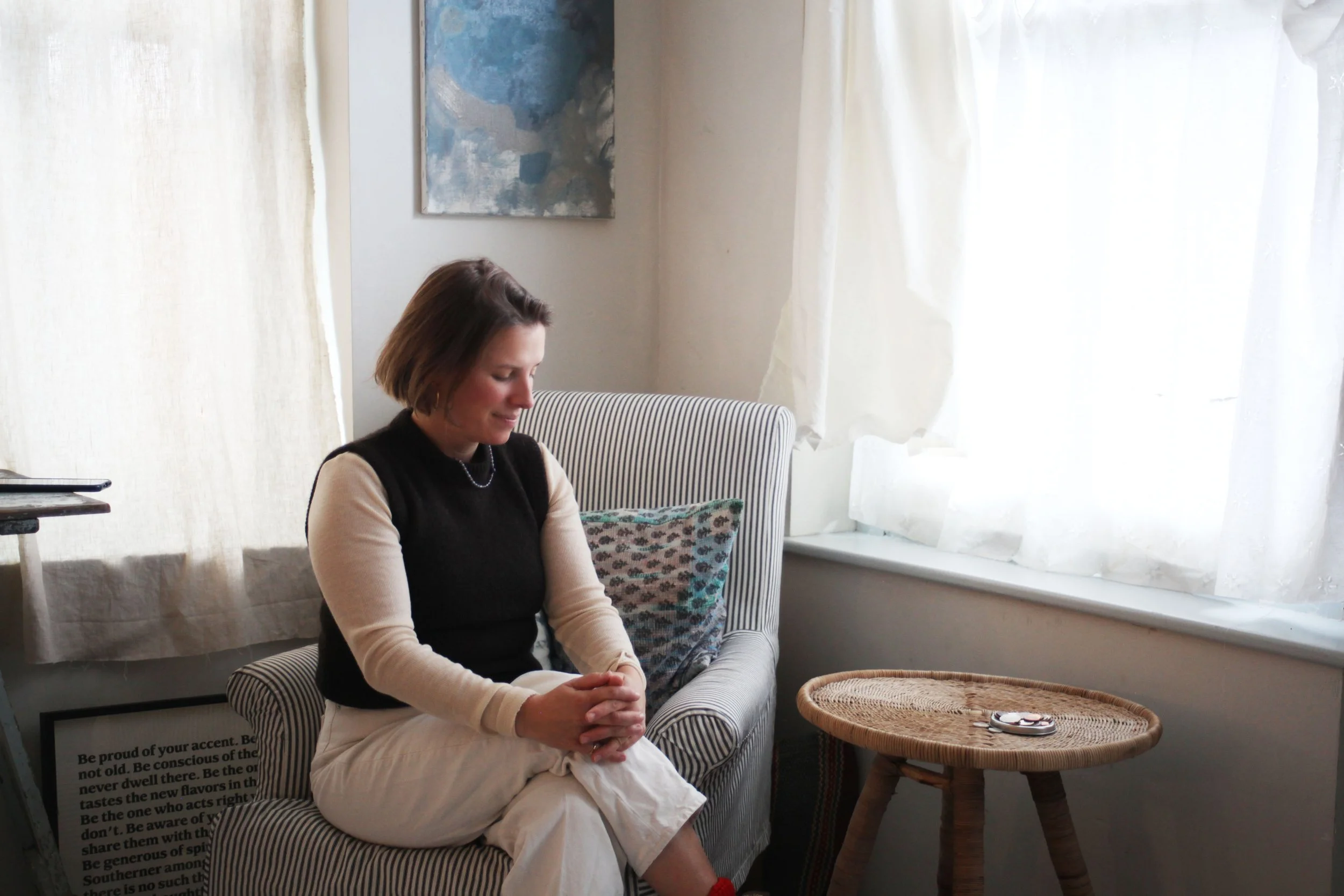22. Rosie Ramsden
“I find a deep creative uplift from being so encompassed by weather, moonlight, streaming sunshine, wild winds…”
I have admired the work of artist and food stylist Rosie Ramsden ever since I started The Worshipful in 2020. She is one of the four artists with whom I am launching the new Worshipful art offering, so of course I had to interview her. Living in North Yorkshire since 2021, before that she lived in Clapton with her husband and young family, until the lure of the countryside became too much to ignore.
For fifteen years, Rosie has worked as a food stylist and recipe writer, writing a book, The Recipe Wheel in 2014 and styling the cookbooks of Thomasina Miers, Flora Shedden and fellow Worshipful interviewee Anna Jones, to name a few. But throughout her food career, Rosie has always painted. “I paint without any formal training. It’s always something I’ve felt the need to do, a crucial aside to my other career as a food stylist. It balances my every day and without it, I am left feeling hollow”
Rosie is self-taught, although creativity runs in the family – she says they are almost all painters, carpenters, designers or ceramicists. Her mother is a retired restorer of oil paintings, and Rosie is certain this strong pedigree has heavily impacted her own creativity.
Growing up on the Isle of Wight, Rosie found a strong connection with nature and the seasons: “we lived very close to the cliff, my parents still do, so it was an easy escape, feeling the sea and the wind and the cold water. I find a deep creative uplift from being so encompassed by weather, moonlight, streaming sunshine, wild winds…”. This still informs Rosie’s practice today, and although they are no longer so close to the coast, she believes their rural environment is the driving force behind most of her work.
Her impetus to get into the studio usually stems from something she has read, often lines in poetry by writers such as Lemn Sissay (another Clapton local), Ocean Vuong, TS Eliot, or works by Olivia Laing with her philosophy on nature: “it’s not as highbrow as it sounds, I don’t trawl these books; it can take just one stand out sentence that makes me brim with ideas”.
Rosie tells me she most enjoys the solitude of the studio – “I love the sketch, the beginnings, the mixing of paints. The rest is made in more of a sleep state”. In terms of her routine, she says she’s a big believer in candles at breakfast and I am absolutely going to start doing this myself, now that the days are shorter. “I used to find winter a struggle, now I try to break through that with low warm light, constant candles, walks at dusk. It helps and I now find winter my most productive time. I get scattier and more easily distracted in summertime”.
I asked Rosie whether living in a more rural environment impacts the way she approaches her work: “we’re so out in the open that the ability to find a quiet thought is easy. It’s changed the way I absorb nature, away from the city noise. I now have a proper (if cold and spidery) studio where I can make a mess and get into the flow of work, so that has been transformative”. Like most creatives, she finds inspiration everywhere, but says she needs a regular gallery fix. Otherwise it’s films, books, walks and long conversations on the phone - “check-ins with my favourite women are instrumental to my art, too. I need to offset the quiet of our home with an injection of culture on a regular basis, as well as hearing the ideas of others”.
Like all working mothers, Rosie has found parenting to be one of the biggest obstacles to a smooth working life, “yet I think it’s one of the things that drives me to be more exploratory, more efficient with my time, an essential element to making a business financially viable, too. It’s amazing what you can squeeze into such a short working day. I feel so grateful every day that I can make my work fit alongside life and alongside the food styling”.
She derives the greatest pleasure from the way that painting expands the way you can see the world: “I love painting in an abstract way to reform my viewpoint. It allows me to stretch imagination, while simultaneously focusing on what’s right at your feet”. Rosie says she’s not much of a future-thinker, but that she has plans to start work on some pieces on a larger scale, and to incorporate some textiles to add movement. I’m so excited to see how these turn out.
As with all of these interviews, we close by my asking her for recommendations for other women creatives in her orbit. She struggled to narrow it down, but admires the work of the painters Molly Martin, Alice Neave and Sammi Lynch as well as her sister-in-law, Mary Ramsden (you can absolutely expect work by all of these woman to appear on The Worshipful Instagram feed in the coming weeks). “It’s just such a good feeling out there for female artists. There’s a buzz, people are making and creating so many interesting, tender, beautiful things”.
What a perfect way to end.
Find Rosie’s work in the shop here, on Instagram here and on her own website here. You can buy her book, The Recipe Wheel, here.
End note: I wasn’t able to get up to Rosie’s studio in North Yorkshire in person before publishing this interview, so huge thanks to Bec Hudson Smith for these (second row). Thanks also to Kristin Perers for allowing us to use the Flower Factory Studio to shoot the main images.










